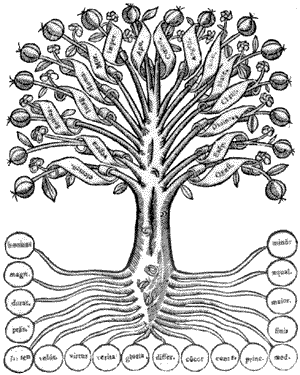Erscheinung, apparition, manifestação, aparecimento, apariencia, appearance, Erscheinende, Erscheinen
Le phénomène au sens d’apparition, n.p.c. avec Phänomen, celui-ci n’« apparaissant » pas (Martineau)
Le mot Erscheinung, qu’emploie Kant dans la Critique de la raison pure, est en règle générale traduit par phénomène, au sens que prend ce terme dans son oeuvre. Dans Sein und Zeit, le mot phénomène étant réservé à la traduction de Phänomen, mot qu’emploie Heidegger dans le sens spécifique qu’il va préciser au § 7 qui suit, deux solutions seront employées pour éviter toute ambiguïté au lecteur. Soit Erscheinung sera traduit par apparition (cf. plus loin note N8, alinéa 6 du § 7 A, page (29)), soit, si le mot est traduit par phénomène, le mot allemand (Erscheinung), entre crochets, lui sera accolé. (ETJA)
Chamamos de aparecer, parecer e aparência (Scheinen) a esse modo de mostrar-se, no qual o ente “se faz ver assim como…”. (SZ 28)
VIDE: Scheinen e afins
VIDE: Erscheinung
apparition, phénomène (ETEM)
fenômeno (QCOISA)
NT: Erscheinung : apparition; le phénomène au sens d’apparition ; ne pas confondre avec Phänomen, celui-ci n’« apparaissant » pas. (ETEM)
NT: ‘. . . was man “Erscheinung” oder gar “blosse Erscheinung” nennt.’ Though the noun ‘Erscheinung’ and the verb ‘erscheinen’ behave so much like the English ‘appearance’ and ‘appear’ that the ensuing discussion presents relatively few difficulties in this respect for the translator, the passage shows some signs of hasty construction, and a few comments may be helpful. We are told several times that ‘appearance’ and ‘phenomenon’ are to be sharply distinguished; yet we are also reminded that there is a sense in which they coincide, and even this sense seems to be twofold, though it is not clear that Heidegger is fully aware of this. The whole discussion is based upon two further distinctions: the distinction between ‘showing’ (’zeigen’) and ‘announcing’ (’melden’) and ‘bringing forth’ (’hervorbringen’), and the distinction between (’x’) that which ‘shows itself’ (’das Sichzeigende’) or which ‘does the announcing’ (’das Meldende’) or which ‘gets brought forth’ (’das Hervorgebrachte’), and (’y’) that which ‘announces itself’ (’das Sichmeldende’) or which does the bringing-forth. Heidegger is thus able to introduce the following senses of ‘Erscheinung’ or ‘appearance’:
1a. an observable event y, such as a symptom which announces a disease x by showing itself, and in or through which x announces itself without showing itself;
1b. y’s showing-itself;
2. x’s announcing-itself in or through y;
3a. the ‘mere appearance’ y which x may bring forth when x is of such a kind that its real nature can never be made manifest;
3b. the ‘mere appearance’ which is the bringing-forth of a ‘mere appearance’ in sense 3a. Heidegger makes abundantly clear that sense 2 is the proper sense of ‘appearance’ and that senses 3a and 3b are the proper senses of ‘mere appearance’. On H. 30 and 31 he concedes that sense 1b corresponds to the primordial sense of ‘phenomenon’; but his discussion on H. 28 suggests that 1a corresponds to this more accurately, and he reverts to this position towards the end of H. 30. (BTMR)
Le mot Erscheinung, qu’emploie Kant dans la Critique de la raison pure, est en règle générale traduit par phénomène, au sens que prend ce terme dans son oeuvre. Dans Sein und Zeit, le mot phénomène étant réservé à la traduction de Phänomen, mot qu’emploie Heidegger dans le sens spécifique qu’il va préciser au § 7 qui suit, deux solutions seront employées pour éviter toute ambiguïté au lecteur. Soit Erscheinung sera traduit par apparition (cf. plus loin note N8, alinéa 6 du § 7 A, page (29)), soit, si le mot est traduit par phénomène, le mot allemand (Erscheinung), entre crochets, lui sera accolé. (Auxenfants; ETJA:§6)
Alexander Schnell introduit ici deux expressions qui permettent de mieux distinguer ce à quoi correspondent les deux premières façons de se montrer qui ont été mentionnées, qu’il qualifie d’auto– donation, de ce à quoi correspondent la troisième, à savoir l’apparition, et la quatrième, à savoir la
« simple apparition », qu’il qualifie d’hétéro-donation. (SchnellEMOF, pages 24-26). Compte tenu des difficultés de traduction qui vont se présenter dans toute cette subdivision, et pour sa clarté, je ne traduirai pas systématiquement Erscheinung par apparition et conserverai, selon le contexte, la traduction courante de ce mot par phénomène, son autre sens philosophique courant (tel que l’emploie Kant dans la C.R.P. par exemple). Pour éviter les confusions avec la terminologie heideggerienne, je renvoie aux conventions de traduction précisées à la note N13, alinéa 10 du § 6, page (23). (Auxenfants; ETJA:§7)
